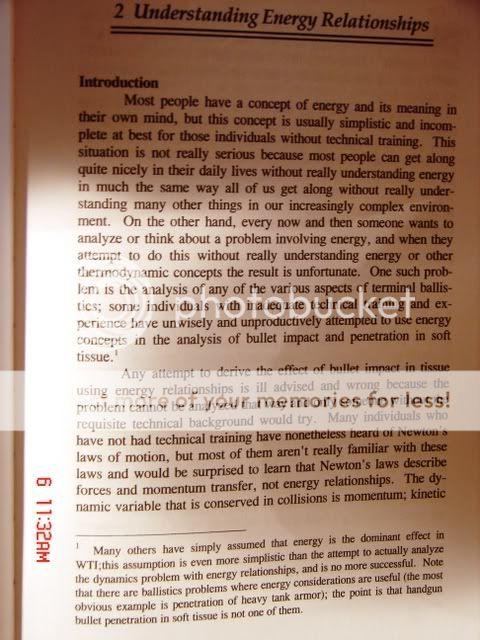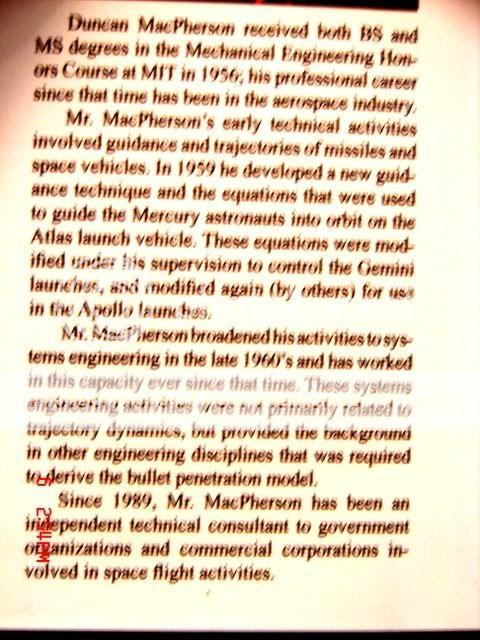Well I've done some research on Mr. McPhearson in the last couple days and though I'm sure he's a very accomplished engineer. His credentials as a ballistician consist of being consulted by conspiracy theorists about the JFK assasination, and publishing the book you have so generously promoted as the end all discussion on terminal ballistics. Unfortuneatly, he has not published one single scientifically reviewed journal article on the subject of ballistics. He is apparently more than happy to make money on his "expertise" in the field, as long as his claims are not subjected to the scrutiny of his peers in the scientific community. I think that about sums it up.
Apparently Dr. Martin Fackler is fairly impressed by Mr. MacPhearsons work as indicated by his review of MacPhearsons book
Review of Bullet Penetration by Dr. Martin Fackler
This review, written by Martin L. Fackler, MD, appeared in the January 1995 issue of Fighting Firearms and is reproduced with the kind permission of the International Wound Ballistics Association.
This remarkable book by Duncan MacPherson advances wound ballistics to the status of a mature predictive science. One must consider the normally slow growth evidenced in the history of scientific methods and ideas to appreciate the significance of this achievement. We have had a valid tissue simulant with which to do bullet testing that is applicable quantitatively to the human body for only a dozen years: for only half that time has this tissue simulant been used widely in a way that gives comparable results ("BB" penetration calibration of each block).
Bullet Penetration unveils MacPherson's unique mathematical predictive bullet penetration model which he derived from the general equations of motion. He used the methodology described above for experimental shots with various projectiles into calibrated 10% gelatin to validate his model and determine its empirical constants.
Several years ago, when Duncan MacPherson tried to explain to me the necessity for a mathematical bullet penetration model, I didn't understand why it was needed or how it might be applied. If I had any question about the effectiveness of a new bullet I would just shoot it into 10% gelatin and measure the results. I didn't even have to do gelatin shots to answer most of the questions I was asked about bullet performance. I could usually make a pretty accurate estimate by mentally comparing the bullet in question with the results of the several thousand bullets I had already tested. Finally, after MacPherson's experimental verification of his model was nearly finished, it dawned upon me that his predictive penetration model does essentially the same thing as my experience based estimates did -only his model does it more accurately and it can be applied to a far wider variety of questions. It puts the equivalent of more than a decade of systematic bullet testing experience at the fingertips of any intelligent reader who is willing to think the model through.
MacPherson derived his model using the rigorous mathematics and physics required for scientific accuracy: this derivation is included in a 35 page chapter that will satisfy the most critical mathematically oriented reader. MacPherson's writing style and vocabulary, however, make the basic principles and results understandable to the layman.
MacPherson has included an outline of the contents of his book's chapters in the introduction, as well as providing an excellent summary at the end of each chapter. He exposes and corrects common fallacies -- such as the presumption that kinetic energy determines bullet effect. In that section we find:
Newton's laws of motion describe forces and momentum transfer, not energy relationships
Damage is done by stress (force), not energy.
Stresses cause damage only if they strain body tissues above their elastic limits. Most expanding handgun bullets simply waste the kinetic energy used in producing the small temporary cavities they cause.
Included is an excellent clarification of statistics for the layman. It explains how the seemingly plausible collection of data from shootings is immensely compounded by the large number of variables; that any claim that incapacitation from bullet hits can be assessed within a few percent based on shooting data "is based on ignorance, or fraud, or both." This easy to understand primer on statistics should enable the layman to avoid being misled by data that is "too good to be true."
Although MacPherson derives his penetration model with the rigor necessary to satisfy the most critical professional scientist. he also provides graphs derived from the model to enable the interested layman to apply the information easily. For example, his model permits the interested reader to obtain the maximum in accuracy from bullet testing in ordnance gelatin. Calibrating each gelatin block with a "BB" shot (at 590 ft/s) gives a quality control check, but within the calibration standards (+/- 1 centimeter of the 8.5 cm standard penetration depth) there can be a variation of +/- 12% (and many laboratories are reporting shots in which the BB penetration does not meet these standards). From MacPherson's graphs the reader can obtain the adjustments to normalize results to the standard 8.5 cm even if the calibration shot was several cm from the 8.5 cm standard. This normalization of experimental results cuts out a large source of potential error, that has heretofore been overlooked, and allows more accurate bullet performance comparisons.
MacPherson includes graphs that allow the reader to obtain a realistic approximation of bullet penetration in gelatin from bullets recovered from shots into water. The expanded bullet's diameter, weight, caliber, and velocity, plotted on the appropriate graph, allows the reader to read off the equivalent penetration depth in 10% standard gelatin (calibrated to a "BB penetration depth of 8.5 cm.)
The photographs relating striking velocity to deformation and expansion for various cast lead projectiles and jacketed expanding handgun bullets should prove exceptionally useful to those who experiment with, or are interested in, bullet
design -- or are just interested in understanding better what they have seen in their own experimental work or that of others.
MacPherson's credentials are impressive to say the least -- he is, in fact (no joke), a rocket scientist -- whose accomplishments include developing a new guidance technique and the equations that were used to guide the Mercury astronauts into orbit. He is now a busy consultant in space flight with an impressive clientele. Duncan has had a lifelong interest in firearms as a shooter and experimenter and has read widely in the field. He demonstrated the depth of his insights into bullet effects when, in 1976, he published "Relative Incapacitation BULListics." That article analyzed and pointed out the fatal flaws in the now infamous Relative Incapacitation Index (RII). The National Institute of Justice NIJ, originator of this ill-fated bullet rating scheme, disregarded MacPherson's well-founded criticisms. in 1986, two FBI agents had to die, unnecessarily, (in the Miami shootout) to prove to the world that MacPherson was entirely correct when he pointed out, ten years previously, that the RII was seriously flawed.
The strongest focus of MacPherson's work is on getting the maximum efficiency out of the inherently limited handgun. He discusses accuracy, recoil, calibers. bullet types, bullet velocities and bullet weights; relating all of these to his wound trauma incapacitation model (which is his penetration model with human anatomy, physiology and psychology and other considerations added).
This superb book can provide those responsible for weapon and bullet selection with the reliable information they need to make informed choices -- to balance intelligently the inevitable pros and cons that accompany these compromises. It further provides data and insights that are of crucial importance to Wound Ballistics Researchers, Forensic Pathologists. Firearms Examiners, Trauma Surgeons, Ordnance Engineers, Law Enforcement Personnel and others critically dependent on firearm performance.
MacPherson's book is a scholarly scientific work. It is not for those who prefer their facts predigested and spoon fed -- it is for mature minds that are willing and able to think for themselves. Rather than just doling out answers, MacPherson gives his readers the tools they need to figure out the best answers to their own particular bullet-effect-related problems for themselves.
Martin L. Fackler, MD


